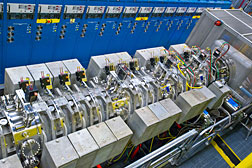- Number 368 |
- July 30, 2012
A three-lab “virtual laboratory” to study heavy-ion fusion

The NDCX-II accelerator.
DOE’s Lawrence Berkeley National Laboratory is home to the second-generation Neutralized Drift Compression Experiment, NDCX-II, designed and built by the Heavy Ion Fusion Science Virtual National Laboratory (HIFS VNL), whose member institutions also include DOE’s Lawrence Livermore National Laboratory and Princeton Plasma Physics Laboratory.
NDCX-II’s aim is to deliver enough concentrated power to boost a metal target into the regime of so-called warm dense matter. “Warm” describes temperatures in the thousands of degrees Kelvin as found in the cores of giant planets like Jupiter and other astrophysical objects, but warm dense matter is also a transient state on the path to self-sustaining nuclear fusion, measured in millions of kelvins and decidedly hot.
“What makes NDCX-II unique is the ion beam’s charged-particle density,” says Joe Kwan of Berkeley Lab’s Accelerator and Fusion Research Division (AFRD), the NDCX-II project director. “The beam is optimized to deposit most of its energy in the thin target itself, heating it instantly to warm dense matter conditions.”
Thus NDCX-II is a test bed for investigating the acceleration, compression, and focusing of intense ion beams with methods that will be key to the heavy-ion accelerators needed for driving inertial-confinement fusion power production. NDCX-II is not a heavy-ion accelerator itself, but does use an induction linear accelerator to accelerate and compress bunches of light lithium ions to moderate energies. The linac and the neutralized-drift compression system shape the ion pulse so as to deposit about three million electron volts of kinetic energy per ion – most of the pulse energy – onto a one-millimeter-diameter spot on a target made of thin aluminum foil, all within a nanosecond.
The induction principle, familiar from transformers, involves two windings through which an electrical current flows; the current in one winding induces a varying magnetic field in the second winding and thus transfers energy to the new current.
“The NDCX-II is like a string of transformers,” says Kwan. “The beam itself acts as the second winding, and its energy is boosted as it passes from induction cell to induction cell.”
The induction cells were previously used for Lawrence Livermore’s Advanced Test Accelerator, then modified and rebuilt at Berkeley Lab, along with new diagnostic “intercells” for monitoring beam quality. The upstream induction cells are powered by long-pulse voltage generators, but as beam pulses accelerate and become shorter, 250,000-volt, short-pulse sources called Blumleins, also from Livermore, supply the power.
Coulomb charge among the 200 billion lithium ions in a pulse strives to blow it apart, so pulses are initially spread out lengthwise. The long pulses are deliberately formed at the front end of the accelerator so that their tails have a higher velocity than their heads.
When a beam pulse reaches the end of the linac it enters the neutralized-drift compression chamber. A central component is a ferro-electric plasma source made of rings of barium titanate ceramic, provided by the Princeton Plasma Physics Laboratory. When high voltage is applied the plasma it produces neutralizes the highly-charged ion beam, allowing the ions to cluster together.
The neutralized pulses are no longer accelerating, so their tails can catch up to their heads; meanwhile they are squeezed radially by magnetic fields. At the precise moment of maximum compaction and focus, the beam hits the target.
NDCX-II was funded in 2009 with $11 million from the American Recovery and Reinvestment Act and completed April, 2012. Design and performance were established with simulations using the Warp-3D code developed by David Grote of Livermore, performed at the National Energy Research Scientific Computing Center (NERSC) by Grote and Jean-Luc Vay of AFRD in collaboration with Alex Friedman of Livermore and AFRD and others. Research will proceed as the project is commissioned in stages.Submitted by DOE’s Lawrence Berkeley National Laboratory
